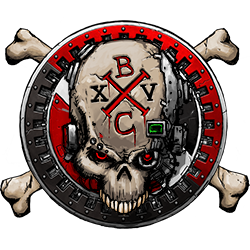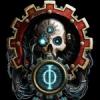Search the Community
Showing results for tags 'The Cipher Legion'.
-
I've been toying with a couple of different custom chapter ideas for a while, maybe to collect, maybe to just have in my head. This is the most detailed one I have. I have a couple ideas for color scheme, but unfortunately paints are slow to arrive these days, so I don't have a test model to show off yet. If you want a rough notion, look up the Knight Atropos on FW's site - the slightly dirty, white-and-dark-gunmetal Xana scheme. It would look extremely boring in a color painter, but could look cool in person. So, anyway: "What is known, is conquered." - Cipher Legion Chapter Motto The Cipher Legion Chapter Name … … … … … Cipher Legion Founding … … … … … … … … 19th Chapter Homeworld … … … Agartha Fortress-Monastery … … … The Hidden City Gene-Seed … … … … … … … Iron Hands Specialty … … … … … … … … Information Warfare, Precision Strikes Battle Cry … … … … … … … … "His eyes are upon us!" History of Agartha The planet known as Agartha is only recorded as the Homeworld of the Cipher Legion in classified records, accessible to Inquisitors or particularly nosy generals. Throughout most of the Imperium's bureaucracy, Agartha is listed as a quarantined world - one of many deemed unsuitable for settlement due to some corruption or contamination that need not be explained. Its appearance from orbit is no less foreboding - wracked with near-constant electrical storms, attempting to land on the planet is suicidal. During the ancient days of the Great Crusade, a handful of attempts were made to land on the planet's surface, but all were met with failure. Mechanicum and Astartes transports were struck from the sky, and those few that may have landed safely were cut off and unable to return. The Crusade, unable to waste any more time or resources on such a place, moved on. Over the Millennia, various attempts to penetrate the world were made, but none saw any real success until M35 when a convocation of Electro-priests came to investigate the planet. Many came to regard the place as holy, and after making extensive modifications to their landing craft they were able to enter the atmosphere - though the transit killed the servitor pilots. They landed on an expanse of grey cliffs, locked into perpetual dusk by the dull blue illumination of the highly-charged clouds above. They found Agartha to be inhabited by dozens of clans of techno-tribesmen, each tattooed with what seemed to be artistic interpretations of blueprints or circuit diagrams. Though they had limited infrastructure or manufacturing capacity, each clan had a remarkable mastery of what little technology was left to them. Vast siphon-towers pulled energy from the atmosphere, feeding each clan's devices. Enormous solar lamps replaced the planet's nearly-absent sun for agriculture. Skirmishes were fought with storm-spears and simple arc weaponry. Stranger still were the clans' shamans, who claimed that by communing with the storm, they could cast their spirits across the planet, communicating the shamans of distant tribes. This they claimed, despite showing no signs of psychic ability. Most notable of all, when the Priests arrived, the clansmen bowed. Millennia ago, the Mechanicum and Astartes forces stranded on the planet's surface had not abandoned their mission. Even without any apparent possibility of rescue or contact, they had brought the planet into compliance. The clans had been primitive then, barely surviving on fungi scraped from caverns beneath the surface - the Mechanicum had uplifted them, and the Astartes had taught them strength, all in anticipation that they may one day have the opportunity to serve the Imperium. Though those original forces had long since passed, the clans still remembered. Though their languages were largely incomprehensible to the priests, the words "Emperor" and "Omnissiah" always carried weight. Over the subsequent century, the electro-priests formed a temple on the planet's surface. Integrating their practices with those of the local shamans, they believed the storm itself was alive, a sentient manifestation of the Motive Force. They identified smaller entities - storm spirits, voltageists, mag-sprites - which had spun off of the larger one. They developed techniques for creating corridors through the storms. Safe travel to and from the surface became possible, at least for anyone in the priests' good graces. Some years later, the idea of founding an Astartes Chapter on the world was put forth. Its location placed it in striking distance of several threats, and its inhabitants had been noted as both strong and exceedingly clever. History of the Chapter The Cipher Legion's first Chapter Master was the Iron Hands veteran Marr Golan, a highly respected member of Clan Kaargul and heir-apparent to that clan's captaincy. It was at the insistence of the Chapter Master that the illusion of quarantine was maintained - he had grand plans for his new chapter, and wished to ensure that none would meddle in them. Even as the Chapter's fortress-monastery was still under construction, Golan founded a city around its base. He siphoned ten percent of each clan's population - their best and brightest - to populate the new city, where every clan's disparate technological knowledge was synthesized and combined with that of the various tech-priests invited the world. Remarkably, they were even able to recover some ancient equipment from the original landings, though an enormous amount of work was needed to restore any of it to working order. Finally, Golan approached the Electro-priests. They yielded the secret of the corridors, so that the chapter would be able to control transit to and from Agartha's surface. Beyond that, however, they convinced him to stand before the Motive Force to seek its approval and validation. This, more than anything, would earn the reverence and acceptance of Agartha's people. With some reluctance, he allowed a network of electoos to be implanted beneath his skin, that he might better channel the storm's power. And then he climbed the tallest siphon-tower on Agartha, immersing himself in the storm. On that tower, Marr Golan experienced what he later described as a single moment of "total understanding." His senses became unbound from his body and enveloped the entire planet - he could see every Agarthan, hear their heartbeats, and understood how each was connected to the others. He saw the chapter's future - not by peering through time, but simply by having enough information and intellect to project the likely course. The whole world was his for these few seconds before his body and mind could no longer bear the stress and he fell unconscious. This single experience changed him, and would define the chapter forever after. In the aftermath, the Chapter Master became more intense, more analytical. Desperate to recapture the expanded cognition granted by the storm, he requested and received numerous neural augments from his Mechanicus allies. The chapter's early engagements were characterized by extremely complex plans formed after long periods of scouting and analysis. While these often led to success, they frustrated many of the new chapter's appointed observers, who consistently pushed for bolder action. When asked to explain himself after a battle, Marr Golan would begin by outlining a vast mathematical matrix reflecting the forces involved as well as any number of other relevant factors. While some in the Adeptus Mechanicus regarded him as a genius, most other observers simply found him incomprehensible and irritating. He adopted the practice of having translators explain his plans to these outsiders, which only widened the rift. Marr Golan's techniques for tactical analysis, while extremely complex, were not impossible to teach to others. The chapter's first captains were selected largely on the basis of their ability to grasp, employ and expand upon them. They spread downwards throughout the chapter, to the point where initiates were expected to spend at least as much time on mental exercises as physical training. Warfare The chapter's way of war is based on the acquisition and exploitation of information - every target is exhaustively scouted, analyzed and tested. Extensive simulations are run to calculate every conceivable outcome, and the history of similar engagements is reviewed and applied. No battle is fought in reality without having first been fought a dozen times in theory, and only then if those theories suggested victory. This deliberate approach has, at times, attracted the ire of the chapter's peers: those Astartes born to more boisterous chapters will often come to regard the Cipher Legion as slow, overly cautious, or even cowardly. Indeed, while their approach has produced some shocking victories from scenarios that appeared unwinnable to less careful observers, it is undeniably true that it has occasionally cost them battles that might have been won had they acted more immediately. They have worked to adapt over time, to cover this weakness with new methods and tactics, but at the core they remain staunch defenders of their process. Organization To outsiders, the Cipher Legion may not appear to have any organization at all. Their internal structure is largely obscured to outsiders due to their apparent contempt for consistent, serialized iconography. Though they do indeed have ten companies with relatively consistent roles, individual marines are not at all clearly marked, and members of the same squad may not appear to have much heraldry in common at all. The one consistent piece of Heraldry is the chapter's symbol, the veiled skull. It represents several things: the consequences of blindness, the transcendent sight of martyrs, and the sacrifice of the electro-priests who are the chapter's spiritual guides. The first company is the chapter's most keenly honed blade, its veterans and elites. Their performance on the battlefield is proven and reliable, resulting in a kind of mathematical certainty that the chapter regards as almost holy. The subsequent chapters are arranged in much the usual fashion, concluding in the tenth, composed of recruits and vanguard forces. Like many chapters in the wake the Indomitus Crusade, the Cipher Legion has adopted a permanent standing force of Vanguard marines, which it rapidly deploys to new battlefields to gather information and account for scenarios where inaction may cost the chapter dearly. Somewhat unique is the role of the Company Champion. While in most chapters a Captain is expected to be a perfect balance of tactical acumen, leadership ability and combat prowess, the Cipher Legion heavily favors the first of these. The Company Champion therefore acts as a sort of counterweight, compensating for the captain's shortfalls wherever they may be. The chain of command recognizes this relationship, and champions occupy an official position equivalent to a senior lieutenant. Beliefs and Culture The Chapter Cult of the Cipher Legion recognizes the Emperor-as-Omnissiah, and frames him as a kind of panopticon: his power comes from his universal sight, seeing and knowing everything throughout the galaxy. This is reflected in their most common battle cry, "His eyes are upon you!" The first chapter master, Marr Golan, is revered as a kind of demi-primarch for his role in establishing the chapter's ethos. The chapter's actual primarch, Ferrus Manus, is a subject of study and respect, but little reverence. Agartha's living storm is also a subject of intense reverence, as a source of power and revelation. Many of the chapter's chaplains hold a dual role as a kind of storm-priest, communing with Agartha's patron spirit alongside the world's resident Electro-priests and experiencing lesser versions of Marr Golan's transcendent vision. While the Ciphers rarely leave the Hidden City, they do mingle freely with its human inhabitants, always interested in whatever projects they might be working towards. Marr Golan's vision of the Hidden City was that it would become a place from which all of humanity could potentially start to rebuild if all else were lost, and to that end the accumulation of knowledge and technology is an ongoing mission. The chapter's analytical approach to war is reflected into their general culture on every level - puzzles, riddles and mysteries are celebrated art forms, as are competitive games of strategy.
- 6 replies
-
- Index Astartes
- Cipher Legion
-
(and 2 more)
Tagged with:


